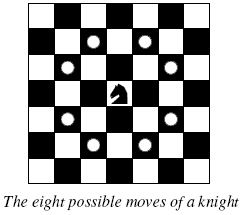A Knight's Journey
| Time Limit: 1000MS | Memory Limit: 65536K | |
| Total Submissions: 22481 | Accepted: 7598 |
Description
 Background
Background
The knight is getting bored of seeing the same black and white squares again and again and has decided to make a journey
around the world. Whenever a knight moves, it is two squares in one direction and one square perpendicular to this. The world of a knight is the chessboard he is living on. Our knight lives on a chessboard that has a smaller area than a regular 8 * 8 board, but it is still rectangular. Can you help this adventurous knight to make travel plans?
Problem
Find a path such that the knight visits every square once. The knight can start and end on any square of the board.
Input
The input begins with a positive integer n in the first line. The following lines contain n test cases. Each test case consists of a single line with two positive integers p and q, such that 1 <= p * q <= 26. This represents a p * q chessboard, where p describes how many different square numbers 1, . . . , p exist, q describes how many different square letters exist. These are the first q letters of the Latin alphabet: A, . . .
Output
The output for every scenario begins with a line containing "Scenario #i:", where i is the number of the scenario starting at 1. Then print a single line containing the lexicographically first path that visits all squares of the chessboard with knight moves followed by an empty line. The path should be given on a single line by concatenating the names of the visited squares. Each square name consists of a capital letter followed by a number.
If no such path exist, you should output impossible on a single line.
If no such path exist, you should output impossible on a single line.
Sample Input
3 1 1 2 3 4 3
Sample Output
Scenario #1: A1 Scenario #2: impossible Scenario #3: A1B3C1A2B4C2A3B1C3A4B2C4
#include <iostream>
#include <cstring>
using namespace std;
const int MAXN = 30;
int m,n;
const int moves[8][2] = {-1, -2, 1, -2, -2, -1, 2, -1, -2, 1, 2, 1, -1, 2, 1, 2};
bool visited[MAXN][MAXN];
char path[MAXN][2];
bool flag;
bool DFS(int x, int y,int setp)
{
if(m * n == setp)
{
flag = true;
return true;
}
for(int i=0;i<8;i++)
{
int p = x + moves[i][0];
int q = y + moves[i][1];
if(p>=1&&p<=m&&q>=1&&q<=n&&!visited[p][q])
{
path[setp][0] = p + 'A' - 1;
path[setp][1] = q + '0';
visited[p][q] = true;
DFS(p,q,setp+1);
if(flag) return true;
visited[p][q] = false;
}
}
return false;
}
int main()
{
freopen("in.txt","r",stdin);
int t,i,j;
cin>>t;
for(i=1;i<=t;i++)
{
cin>>n>>m;
memset(visited,false,sizeof(visited));
memset(path,0,sizeof(path));
flag = false;
path[0][0] = 'A';
path[0][1] = '1';
visited[1][1] = true;
printf("Scenario #%d:\n",i);
if(DFS(1,1,1))
{
for(j=0;j<n*m;j++)
printf("%c%c",path[j][0],path[j][1]);
}
else
printf("impossible");
printf("\n\n");
}
return 0;
}





















 336
336

 被折叠的 条评论
为什么被折叠?
被折叠的 条评论
为什么被折叠?








